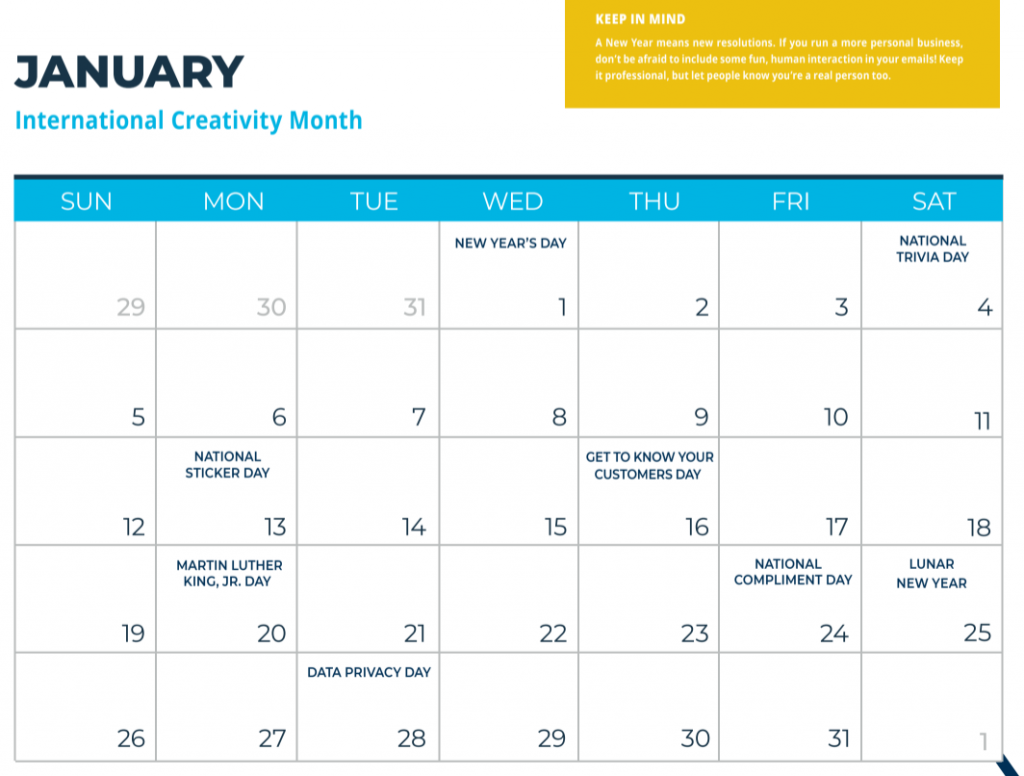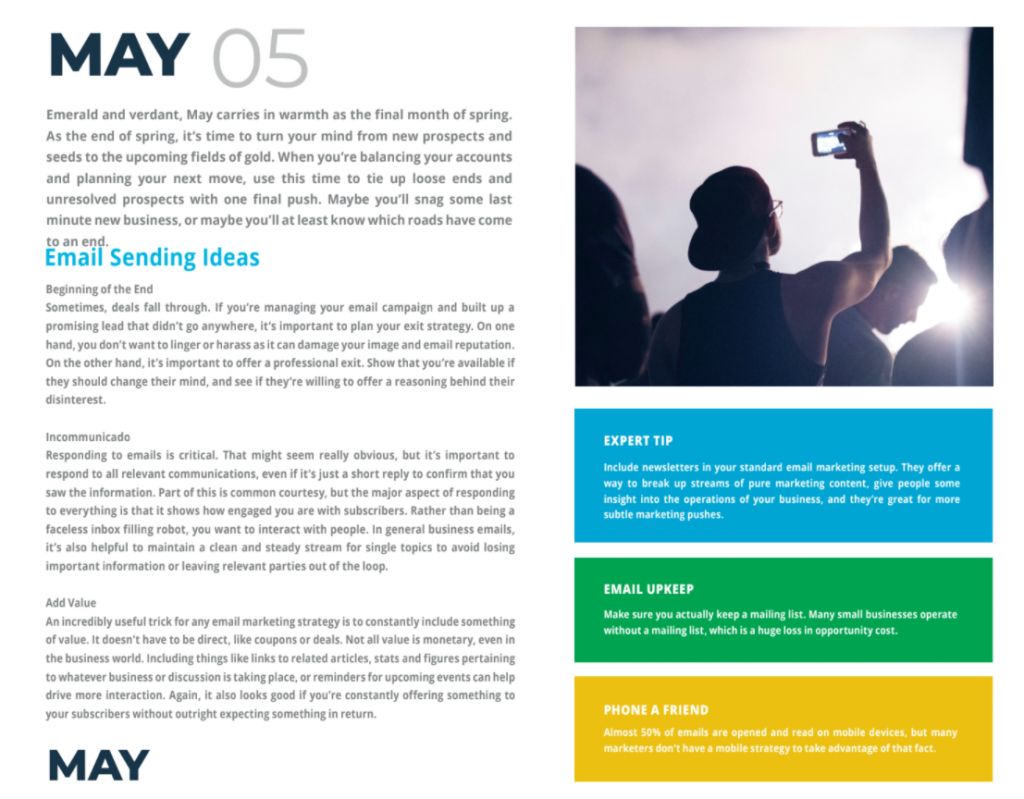
Email Planning Calendar Guide
Email Planning Calendar Guide
It’s the beginning of a new year.
You’re excited about all the opportunities the year will bring, you’re planning all that new business coming your way, right?
And then 2020 happens. And it just keeps happening. And now it’s the fifteenth week of August, the thirteenth month of quarantine, and people are talking about canceling 2021.
So clearly you’ve spent a lot of time thinking about your emails and developing an effective email campaign, right?
No?
You didn’t spend the summer coming up with an elaborate, yet clearly communicated series of emails telling all your loyal customers about that new summer deal? Wow.
Talk about a wasted quarantine. All that time locked up inside, and you’re out here just taking care of your health and doing your best to support your local community by social distancing while trying to keep your business afloat?
I get it, I get it. Don’t worry, I always thought homework was kind of a sham, too. I guess we’ll let you copy our work, but just this once, alright?
Make Email Planning Easy With a Calendar
A while back, we talked about why email marketing is still an important strategy for just about any kind of company.
Basically the consistent appeal to an audience that’s already interested in your brand is a great way to communicate not only new deals and promotions and changes, but it fosters a sense of consistency and regularity. A refresher on the benefits of a good email campaign:
- Consistent access to an audience that already expressed interest in your brand.
- Direct communication for changes, promotions, or important news.
- Room for creative or engaging content that might not fit your other channels.
- A great medium for multi-stage campaigns over longer periods of time.
As you might have guessed, consistency and regularity are in short supply this year. So companies that can take advantage of a solid email strategy might manage to maintain that front-of-mind appeal that brings value to just about any marketing strategy in the first place.
However, email campaigns and planning can be difficult to remember when the world is flip flopping all over the place. Hell, sometimes they’re difficult to manage even when things are perfectly stable.
That’s why we suggest using an email planning calendar to automate the brainstorming part of any ongoing or seasonal email campaigns.
How A Calendar Works
Look, I’m gonna be honest, we’re not reinventing the wheel here.
It’s a calendar.
You open little doors, there’s chocolate inside, every month is 25 days. It’s, like, really religious, and honestly, I’m starting to think I have the wrong calendar sitting in front of me.

But for real, an Email Planning Calendar is a lot like a regular calendar dressed up and turned into a more useful marketing tool. It usually comes equipped with all the standard calendar items — all the standard date and holiday reminders along with a 12-month layout.
The Email Planning and Marketing portion comes from all the added commentary and marketing tips included with each month. For example, let’s take a look at both sections in our Regex SEO calendar for 2020:

The Dates Part
This part looks like most calendars.
You’ve got dates, holiday markers, reminders for daily, weekly, or monthly events, and plenty of room to write in little personal notes or whatever else.
You know, ‘pay bills’ on the 3rd, ‘band practice’ on the 12th, a series of ominous red X’s leading up to the 27th, which is circled in lipstick. Typical calendar stuff.
It’s also a great way to highlight periods of time where your email campaigns are effective so you can keep an eye on different segments or aspects of your campaigns. And I mean highlight in the literal sense.
Take a marker and draw a bright yellow box around whatever campaign you’ve got going on at the moment. Here’s why.
Visualization Helps Organization
It sounds simple, but a lot of people overlook the power of a visual aid in organizing and generating quality email marketing campaigns. As with all marketing, time is a major factor.
Both duration and timing.
Duration
Highlighting or marking your email campaign on the calendar can help you remember how long a promotional campaign is in effect, which in turn gives you a more visual understanding of the start and end dates.
If you see a big two week block hanging out on your desk all throughout May, it’ll be at the front of your mind. You’re going to remember that promotion is active, and you can adjust your new ideas, campaigns, or email sendouts to account for that.
It’s also good if you’re involved in any kind of sales or customer service, because you’ve got an easy reference point for any customer or client that calls in with questions.
Timing
Timing is the next big benefit of this visual component. Basically, if you see that same big block sitting on your desk, you’ll also be more aware of surrounding events and how to account for them.
Speaking personally, I’m terrible at remembering holidays and dates. But if I look up and see a massive pink rectangle around the week before Mother’s Day, I’m probably going to remember Mother’s day, right?
Beyond the practical value of being more aware of your duration and timing, this kind of organization can spur more creative solutions and future campaigns.
Look for spaces where holidays are close together, or find new ways to make use of gaps between promotions by visualizing how to fill that space.

The Guide Part
The other half of our calendar is the collection of tips, guides, and commentary on email best practices that you can find at the beginning of each month.
This part is, unsurprisingly, also fairly self-explanatory.
We started out by making these calendars for ourselves, and since we do a lot of email marketing for our clients, we started putting in useful information and reminders for email campaign techniques.
Initially, it was fairly simple stuff — remember to proof template sendouts in case they don’t copy over well, periodic reminders to clear out emails in order to reduce clutter in the inbox, things like that.

After a while, we added more and more information. Kind of like sticking a bunch of sticky notes all over the calendar until eventually we ended up with what you see here.
Now, as we build more and more campaigns for clients, we research and learn and grow. As we learn more useful techniques or find good information, we’ll add it to a kind of ‘calendar pool’ so we can organize the next year without having to think about it.
So Why a Calendar?
If we spent all this time building email marketing campaigns and learning this information, why bother collecting the information like this?
It’s easy to look at a ton of sticky notes and think, ‘why did I need this?’ or ‘this isn’t even my handwriting’ or ‘maybe I should just tattoo this to my body at this point’. But a calendar seems more practical, and I don’t really need my boss’s phone number tattooed across my forearm.
The real answer is that it’s a useful way to organize all of our relevant reminders in one convenient location.
If we sit down at the end or beginning of each year and write out a micro version of how we intend to run campaigns throughout the next year, we’re significantly more prepared to follow through or address unexpected changes.
Pre-planning
Planning ahead of time is just good business. Plan for success — using specific dates and timelines — and you’ll put yourself in a much better position to adapt or follow through once those goals are met or change.
Giving yourself this time to sit down and actually look at what space is available is a great way to avoid stress or feeling overwhelmed as time marches forward.
Static or Dynamic Tips
Adding new tips or reviewing old advice on an annual basis is kind of like a self-improvement opportunity.
Some of the advice we give for email campaigns in 2020 might be exactly the same as advice we gave ourselves years ago. For example, cleaning out your inbox regularly is a pretty evergreen bit of advice.
But if we look at a piece of advice from 2015 and think ‘Well that’s not true anymore,’ we can strike it from our collection of tips. In doing so, obviously we take it off the calendar, but we also get that moment of realization that our old knowledge is no longer relevant, which means we can improve and update how we handle building campaigns now and in the future.
Putting Our Calendar To Good Use

Basically, a calendar is the perfect way to set up your email planning for the year because it forces you to engage with an incredibly visual version of your timelines.
So we packed a calendar with reminders and tips and mini-guides on sending out good emails, that way we’re way less likely to trip up.
We’ve seen a lot of success using this method in our own offices, so we decided to save you the hassle of making your own calendar and just share ours with you!
You can download our 2020 Email Planning Calendar right here! Steal our ideas, mark it up with your own pens and highlighters, or just enjoy the occasional fun facts we’ve worked into each month’s Email Planning breakdown.

October 19, 2020
I am very much inspired by your articles. I have learned a lot new from your post. You share noteworthy information about the email planning calendar guide. I look forward to more comprehensive and insightful posts like this in the future.